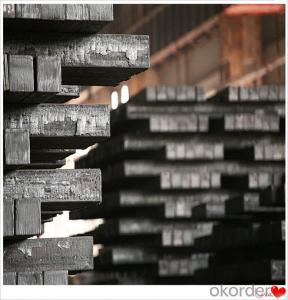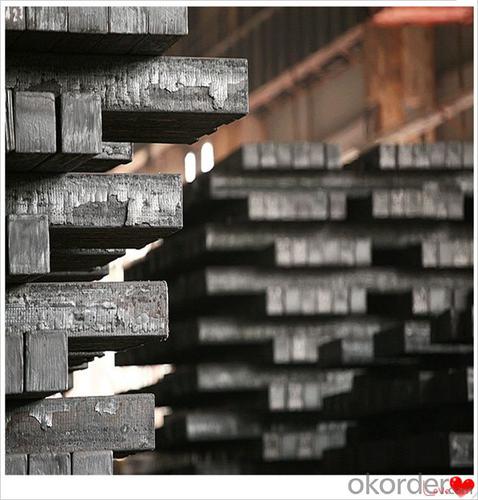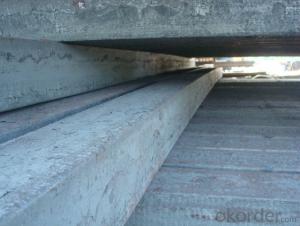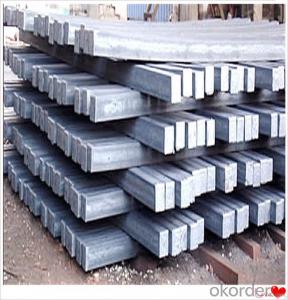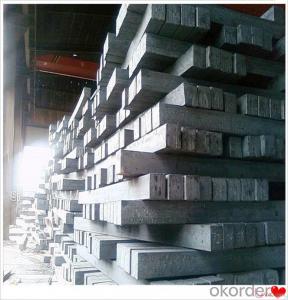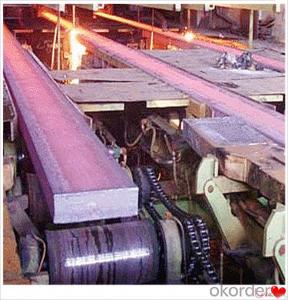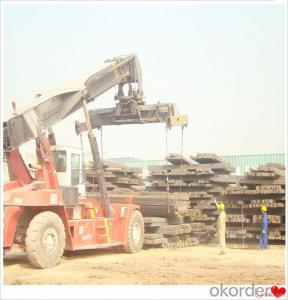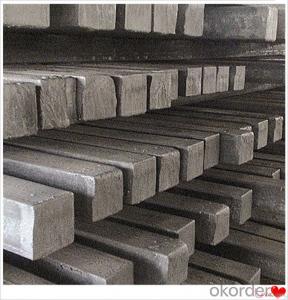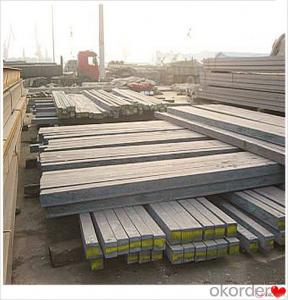Square Steel Billet Size Q235,Q255,Q275,Q345,3SP,5SP,20MnSi
- Loading Port:
- China main port
- Payment Terms:
- TT OR LC
- Min Order Qty:
- 20 m.t.
- Supply Capability:
- 200000 m.t./month
OKorder Service Pledge
OKorder Financial Service
You Might Also Like
Square Steel Billet Size Q235,Q255,Q275,Q345,3SP,5SP,20MnSi
Specification
Steel billet(ingot) by cogging or breakdown of semi-finished products, is the raw material of all kinds of steel mill. Billet section of square, round, flat, rectangular and abnormity of several kinds of, mainly related to the shape of rolled products.
CNBM Q235,Q275,Q345,3SP,5SP,20MnSi Billets Steel
Hot Rolled Steel Billets/ Mild Steel Bar/ Billet Steel
Specification (see below)
Standard: GB/JIS/ASTM
Size: 50*50mm-180*180mm
Length: 3-12mtrs or Customised
Steel material: Q235,Q255,Q275,Q345,3SP,5SP,20MnSi
Technique: Hot rolled
FOB Unit Ton Price $250-350 and Usually I will quote you CFR price.
MOQ: Usually 1000-10000MT/size
Shipment:By Container,Bulk Vessel
Packaging Details: bundles with steel strips or as customers's requirements
Delivery time: Usually within 30 days after the deposit/LC
Inspection:Third party inspection before loading.
Technical data
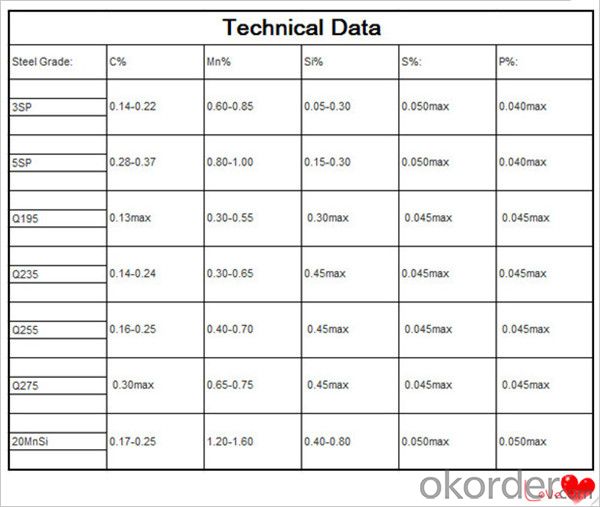
Feature Steel Billet
Rectangular billet continuous casting billet and mainly general carbon steel, low carbon low silicon cold-rolled material, high quality carbon structural steel, high strength low alloy steel, special steel, etc.
The billet is mainly divided into two kinds from the shape:
Slab: cross section width and height of the ratio of the larger, mainly used for rolling plate.
Billet: equal cross section width and height, or a huge difference, mainly used for rolling steel, wire rod. ,
Steel billets have distinct characteristics as compared with already furnished steel bars and products. Billets have a specific grain structure, which enables the metal to be processed more intricately. Steel billets are also known for their malleability and ductility, especially when exposed to varying temperatures during shaping and molding.
Packaging & Shipping
1. Packaging:
1) Small size: in bundles
2)Big size: in bulk
3)in plastic packing or as per customer requirement
2. Delivery time:
1) Normal size: within 7days send from warehouse directly
2) Special size: with 25-30days customer made for you
3. Trade terms:FOB/CFR/CIF
4. Shippment:
1) length:≤5.8m loaded in 20FT Container with 25-27tons
2) length:≤11.8m loaded in 40FT Container with 25-27tons
3) lengnth:≥12m shipped by bulk vessel, FILO terms
Steel Billet Images
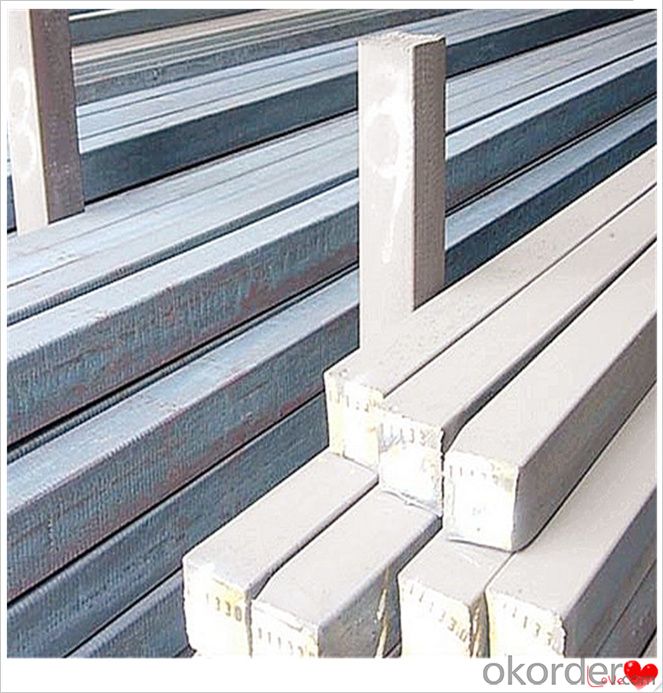
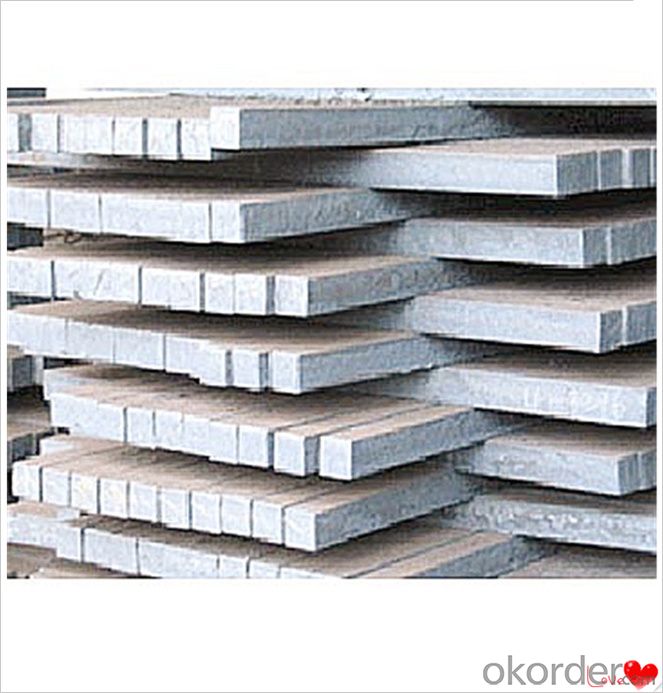
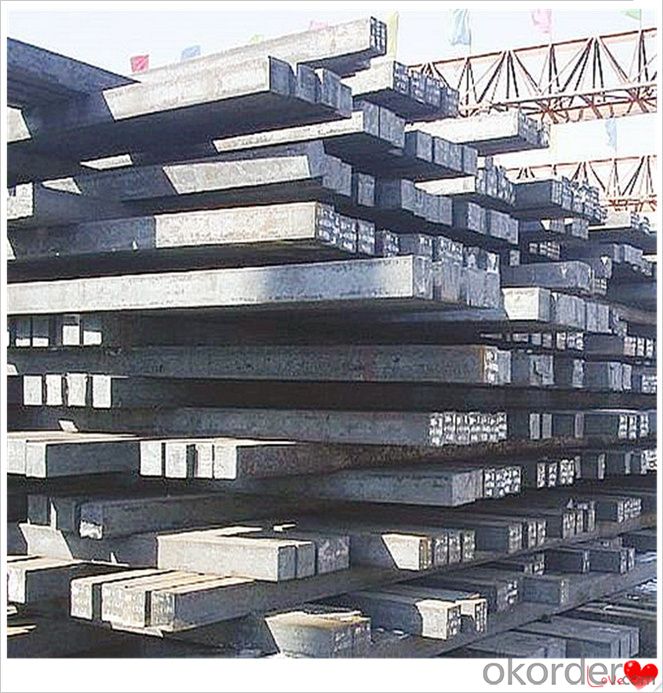
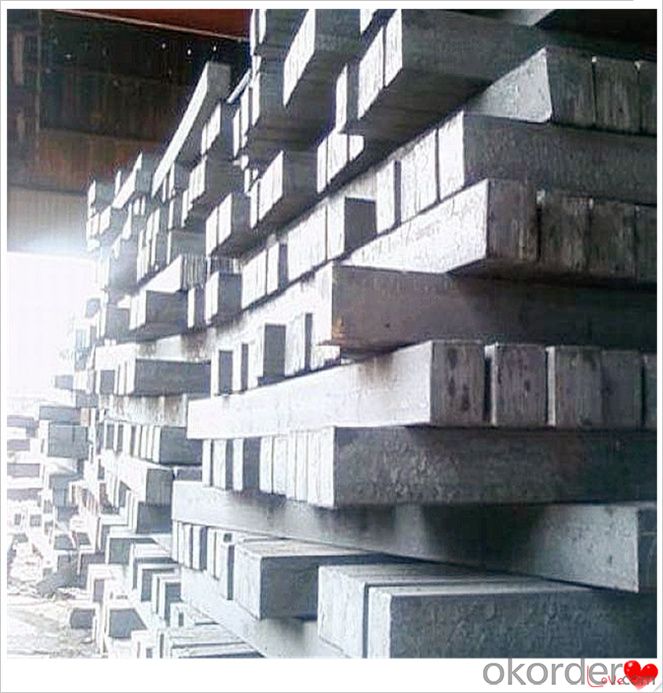
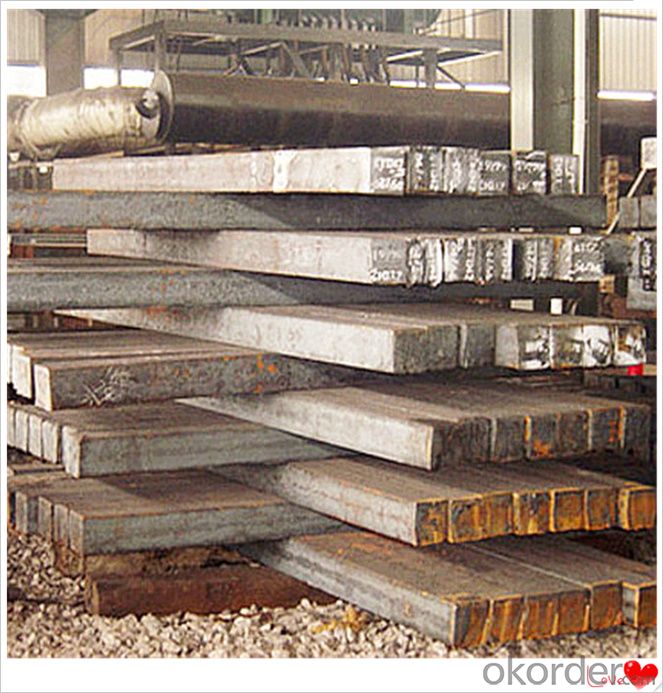
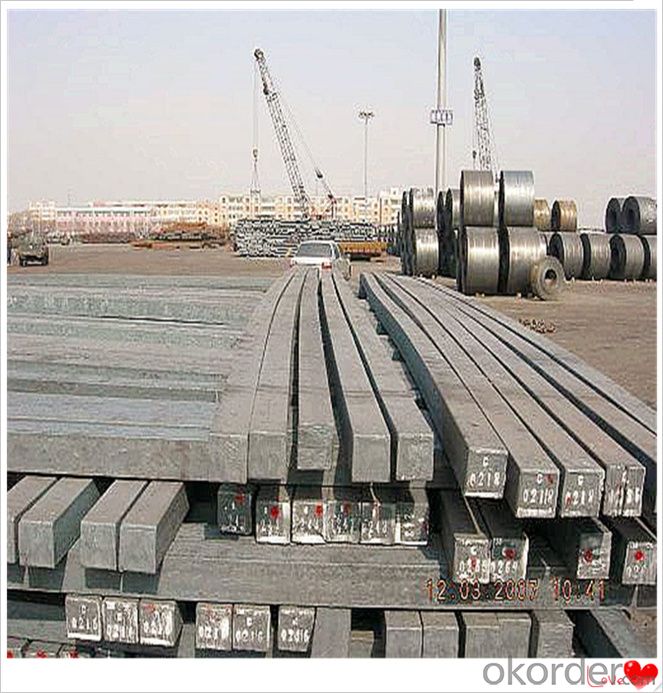
Processing
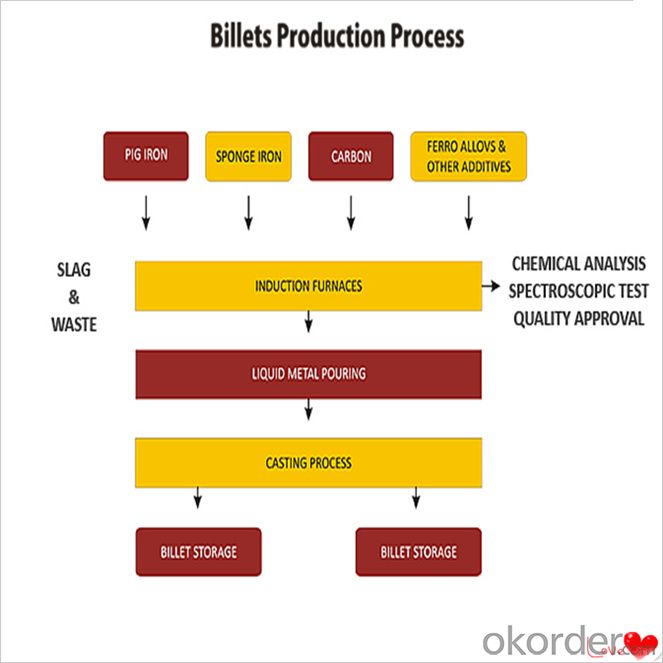
Usage-Billet Steel
Used for the plant, the bridge,shipment building high-rise building construction,lifting and transportation machinery, equipment manufracturing base building the support foundation pile manufacturing.
Billets, or ingots (as they sometimes referred to), are not of practical use until they have been formed into more functional shapes and sizes. While they have already been put in the furnace, they still require a series of shaping and molding procedures such as hot and cold working, milling and cutting before they are sold in hardware stores, or used for different applications. The unformed billets, however, can be used in striking currency such as coins and as reserves, similar to gold bars.
FAQ-Billet Steel
We have organized several common questions for our clients,may help you sincerely:
1) How about your company?
A world class manufacturer & supplier of castings forging in carbon steel and alloy steel,is one of the large-scale professional investment casting production bases in China,consisting of both casting foundry forging and machining factory. Annually more than 8000 tons Precision casting and forging parts are exported to markets in Europe,America and Japan. OEM casting and forging service available according to customer’s requirements.
2) How to guarantee the quality of the products?
We have established the international advanced quality management system,every link from raw material to final product we have strict quality test;We resolutely put an end to unqualified products flowing into the market. At the same time, we will provide necessary follow-up service assurance.
3) How long can we receive the product after purchase?
In the purchase of product within three working days, We will arrange the factory delivery as soon as possible. The pecific time of receiving is related to the state and position of customers.Commonly 7 to 10 working days can be served.
4)Do you have your own QC department?
Yes, we have, our QC department will inspect the goods during the process of mass production and after completion of production.
hot sale!!! Cast Steel Grades/ mild steel bar/ billet steel
(1): High quality steel with reasonable price.
(2): Wide excellent experiences with after-sale service.
(3): Every process will be checked by responsible QC which insures every product's quality.
(4): Professional packing teams which keep every packing safely.
(5): Trial order can be done in one week.
(6): Samples can be provided as your requirements.
- Q: What are the different quality control measures for steel billets?
- There are several quality control measures that are implemented during the production and inspection of steel billets to ensure their high quality. These measures include: 1. Chemical Composition Analysis: The chemical composition of steel billets is thoroughly analyzed to ensure it meets the required specifications. This analysis involves determining the content of various elements such as carbon, manganese, sulfur, phosphorus, and others. Any deviations from the specified composition can affect the mechanical properties of the billets. 2. Dimensional Inspection: Steel billets undergo dimensional inspection to verify their size, shape, and weight. This involves measuring the length, width, and thickness of the billets using precision instruments and ensuring they meet the specified tolerances. Any deviations from the required dimensions can impact the performance of the billets during subsequent processing. 3. Surface Inspection: The surface of steel billets is inspected for any defects or irregularities. This includes checking for cracks, surface discontinuities, surface roughness, and other imperfections. Surface inspection is typically conducted using visual inspection techniques or non-destructive testing methods such as magnetic particle testing or ultrasonic testing. 4. Mechanical Testing: Mechanical testing is performed to assess the mechanical properties of steel billets. This includes conducting tests such as tensile testing, hardness testing, and impact testing to determine the strength, ductility, toughness, and other mechanical characteristics of the billets. These tests ensure that the billets possess the required mechanical properties for their intended applications. 5. Metallurgical Examination: Metallurgical examination involves studying the microstructure of steel billets through microscopic analysis. This examination helps identify any defects in the metal structure, such as grain size, segregation, inclusions, or improper heat treatment. By assessing the metallurgical properties, the quality control team can ensure that the billets are free from any internal defects that might compromise their structural integrity. 6. Non-Destructive Testing (NDT): Non-destructive testing techniques, such as ultrasonic testing, magnetic particle testing, or eddy current testing, are used to detect internal defects or discontinuities that may not be visible through visual inspection. These methods allow for the detection of flaws without damaging the billets, ensuring their integrity is maintained. 7. Documentation and Traceability: Quality control measures also include maintaining proper documentation and traceability throughout the production process. This includes documenting the results of all inspections, tests, and analyses performed on the steel billets, as well as tracking their origin, processing history, and any relevant certifications. This documentation ensures transparency and enables traceability in case of any quality-related issues. By implementing these quality control measures, steel manufacturers can ensure that the produced billets meet the required specifications, possess the desired properties, and are of high quality, thereby enhancing their reliability and suitability for various applications in industries such as construction, automotive, and manufacturing.
- Q: What are the common defects in steel billets during continuous casting?
- Steel billets during continuous casting can experience various common defects. These defects include surface cracks, central segregation, inclusion defects, internal cracks, surface and subsurface defects, and pipe defects. Surface cracks are cracks that appear on the billet's outer surface. They can occur due to excessive cooling or improper mold lubrication. These cracks can weaken the structural integrity of the billet and potentially cause breakage during subsequent processing. Central segregation is a defect that arises from an uneven distribution of elements within the billet. This uneven distribution leads to variations in composition across the billet's cross-section. As a result, the billet may possess inconsistent mechanical properties, making it unsuitable for certain applications. Inclusion defects occur when non-metallic particles or impurities become trapped within the billet during casting. These particles can originate from the refractory lining, mold powder, or the steelmaking process itself. Inclusion defects weaken the material and diminish its overall quality. Internal cracks are cracks that develop within the billet's body. Thermal stresses or improper cooling are often the culprits behind these cracks. Detecting internal cracks visually is challenging, and they can compromise the structural integrity of the billet. Surface and subsurface defects encompass various issues such as surface depressions, oscillation marks, and hot tears. Surface depressions arise from excessive mold oscillation or poor mold conditions. Oscillation marks result from non-uniform mold oscillation, leading to uneven cooling and inconsistent billet dimensions. Hot tears occur when the billet contracts unevenly during solidification, resulting in cracks on the surface or subsurface. Pipe defects are hollow cavities that form within the billet during solidification. Shrinkage is the main cause of these cavities, and they can weaken the material. If these pipes propagate to the surface, they can cause breakage during subsequent processing. Overall, these defects pose significant challenges in producing high-quality steel billets. Continuous improvement in casting techniques, process control, and quality assurance measures are crucial in minimizing these defects and ensuring defect-free billet production.
- Q: How are steel billets used in the production of aerospace structures?
- Steel billets are used in the production of aerospace structures as they are melted and cast into various shapes to create critical components such as beams, brackets, and fittings. These billets serve as the raw material that undergoes further processing, including machining, welding, and heat treatment, to meet the specific requirements and tolerances of aerospace applications. The high strength and durability of steel make it an ideal material for aerospace structures, ensuring the safety and reliability of aircraft.
- Q: How are steel billets used in the production of electrical appliances?
- The production of electrical appliances utilizes steel billets in multiple ways. Firstly, these billets serve as the primary material for manufacturing various electrical appliance components. Depending on the appliance's specific requirements, the billets can be formed and shaped into sheets, plates, bars, or wires. For instance, thin sheets rolled from steel billets are utilized in constructing the outer casing or body of appliances like refrigerators, washing machines, or air conditioners. These sheets offer durability, strength, and protection to the internal components of the appliance. Moreover, steel billets can undergo further processing to create bars or wires essential for electrical connections, circuit breakers, or switches. These components demand high electrical conductivity, heat resistance, and mechanical strength, all of which steel billets can provide. Furthermore, steel billets are crucial in the manufacturing of motors and transformers, integral to the operation of electrical appliances. These billets are shaped and machined to produce specific parts such as rotor cores, stator cores, or laminated cores, necessary for the efficient conversion of electrical energy. In conclusion, steel billets are of utmost importance in the production of electrical appliances as they serve as the essential raw material for creating casings, bars, wires, and cores. The properties of strength, durability, electrical conductivity, and heat resistance make them an ideal choice for ensuring the reliability and functionality of electrical appliances.
- Q: How are steel billets cut into smaller pieces?
- Steel billets are typically cut into smaller pieces through a process called sawing or shearing. There are various methods used to achieve this, depending on the desired size and precision of the cuts. One common method is using a saw blade, either circular or band saws, which are specifically designed for cutting through metal. These saws can be manually operated or automated, depending on the scale of the operation. The billets are clamped securely to prevent movement, and the saw blade is guided along the marked cutting line, gradually slicing through the steel to create smaller pieces. Another approach is shearing, which involves using a shear machine to apply intense force to cut through the billet. This method is often used for thicker billets or when precise cuts are not necessary. The shear machine consists of a fixed blade and a moving blade that come together to sever the billet along the desired cutting line. Additionally, advanced technologies like laser cutting or plasma cutting can also be employed to cut steel billets into smaller pieces. These methods utilize high-powered lasers or plasma jets to melt or vaporize the material along the cutting line, resulting in a clean and precise cut. Overall, the choice of cutting method depends on factors such as the thickness of the billet, the desired precision of the cuts, and the production capacity. Regardless of the method used, safety precautions are always taken to ensure the well-being of the operators and to maintain the quality of the cut steel pieces.
- Q: What are the different surface defects in steel billets?
- Steel billets can have various types of surface defects, which can occur during manufacturing or due to handling and transportation. Some common defects include scale, cracks, lamination, pitting, slivers, rolled-in scale, and surface scratches. Scale forms as a rough, flaky coating during heating and rolling, affecting the billet's appearance. Cracks can be caused by improper cooling, excessive pressure, or stress during handling, compromising the billet's strength. Lamination defects occur when non-metallic layers weaken the billet. Pitting is the formation of small cavities due to corrosion or exposure to corrosive environments. Slivers are thin, protruding pieces caused by improper cutting or shearing. Rolled-in scale refers to embedded scale, requiring additional cleaning. Surface scratches are shallow marks that can affect aesthetics and may need further treatment. Proper identification, handling, and treatment of these defects are essential to ensure the quality of the steel billets. Regular inspection and appropriate techniques can minimize defects and enhance the billets' overall quality.
- Q: How are steel billets used in the production of structural steel sections?
- Steel billets are a crucial component in the production of structural steel sections. These billets serve as the primary raw material for the manufacturing process. To begin with, steel billets are melted in a furnace to create molten steel. This molten steel is then cast into billets of specific sizes and shapes, which can vary depending on the desired structural steel section to be produced. The billets are typically rectangular or square in shape. Once the steel billets have solidified, they are reheated in another furnace to a specific temperature for hot rolling. Hot rolling is a process where the billets are passed through a series of rolling mills to reduce their cross-sectional area and shape them into the desired structural steel sections. This process involves applying high pressure and temperature to the billets, which causes them to deform and elongate. The hot rolled steel sections are cooled and then undergo further processing, such as straightening, cutting, and sometimes additional heat treatment to enhance their mechanical properties. These steps ensure that the structural steel sections meet the required specifications for strength, durability, and dimensional accuracy. The structural steel sections produced from steel billets are widely used in various construction projects. They are commonly used in the construction of buildings, bridges, infrastructure, and other structures where strength and load-bearing capacity are essential. These sections can be found in beams, columns, channels, angles, and other shapes that provide the necessary support and structural integrity. Overall, steel billets play a vital role in the production of structural steel sections, serving as the starting material that undergoes a series of manufacturing processes to create the final products used in construction and other industries.
- Q: What are the properties and characteristics of steel billets?
- Steel billets, typically utilized in the production of various steel products, exhibit numerous properties and characteristics that render them suitable for such applications. To begin with, their exceptional strength-to-weight ratio endows steel billets with immense strength, enabling them to withstand heavy loads. This strength is derived from the steel's carbon content, which enhances its structural integrity. Furthermore, their superb heat conductivity facilitates efficient heat transfer during diverse manufacturing processes. Consequently, steel billets prove ideal for applications involving high-temperature operations, such as forging and rolling. Moreover, their remarkable machinability enables easy shaping and forming into desired products. This property is of utmost importance in the manufacturing industry, as it allows for the production of intricate and personalized steel components. Steel billets also possess outstanding ductility, enabling them to stretch and mold without fracturing. This characteristic proves vital in applications requiring bending or forming the steel into various shapes. In addition, steel billets exhibit a high resistance to corrosion, rendering them suitable for outdoor or corrosive environments. This property guarantees the durability and longevity of steel products manufactured from billets. Furthermore, steel billets can be effortlessly welded, facilitating the fabrication of large and intricate structures. Their weldability renders them versatile and adaptable to diverse construction and manufacturing needs. Lastly, steel billets boast a consistent and uniform composition, ensuring the production of high-quality and dependable steel products. This consistency is achieved through meticulous manufacturing processes and rigorous quality control measures. To conclude, steel billets possess numerous properties and characteristics that make them highly sought-after in the production of steel products. Their high strength, heat conductivity, machinability, ductility, corrosion resistance, weldability, and consistent composition deem them indispensable in various industries, including construction, automotive, and manufacturing.
- Q: How are steel billets used in the manufacturing of hydraulic components?
- Steel billets are commonly used in the manufacturing of hydraulic components as they serve as the raw material for shaping and forming various parts such as cylinders, pistons, and valves. These billets are heated and then subjected to various mechanical processes like forging, rolling, or extrusion to achieve the desired shape and size. The resulting hydraulic components made from steel billets offer high strength, durability, and resistance to pressure, making them suitable for use in hydraulic systems that require reliable and efficient operation.
- Q: What is the purpose of steel billets?
- The purpose of steel billets is to serve as raw material for the production of various steel products. Steel billets are semi-finished products that are typically square or rectangular in shape, and they are produced through the process of casting or hot rolling. These billets are then further processed in various ways, such as forging, rolling, or extrusion, to create finished steel products like bars, rods, wire, pipes, and tubes. Steel billets are crucial in the steel manufacturing industry as they provide a uniform and consistent starting material that can be easily shaped and formed into a wide range of products. They possess desirable properties like strength, durability, and ductility, making them suitable for use in construction, automotive, infrastructure, machinery, and many other applications. The use of steel billets allows manufacturers to efficiently produce steel products with specific dimensions, mechanical properties, and surface finishes. By controlling the composition and processing of the billets, steel manufacturers can tailor the final product to meet the specific requirements of customers, ensuring the desired performance and quality. In summary, the purpose of steel billets is to serve as a starting material for the production of various steel products. They provide the foundation for shaping and forming steel into the desired finished products, enabling industries to meet the diverse needs of modern society.
Send your message to us
Square Steel Billet Size Q235,Q255,Q275,Q345,3SP,5SP,20MnSi
- Loading Port:
- China main port
- Payment Terms:
- TT OR LC
- Min Order Qty:
- 20 m.t.
- Supply Capability:
- 200000 m.t./month
OKorder Service Pledge
OKorder Financial Service
Similar products
Hot products
Hot Searches
Related keywords
